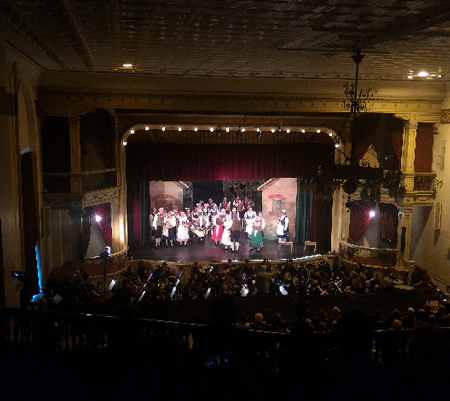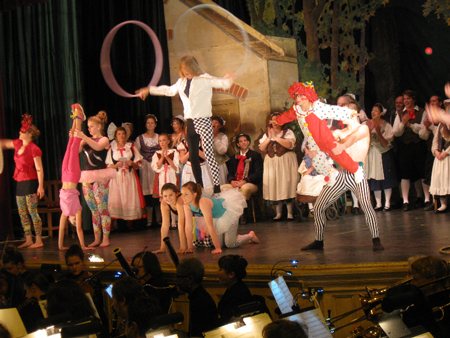by Daniel Hathaway

That feeling was underscored just before curtain time when a long-time friend and colleague waved me over to share a pile of tattered programs from old performances of Bedřich Smetana’s opera — his mother had sung the role of Marenka in 1939, and his aunt the role of Ludmila twenty years later (both in Czech). It was clear that this Bartered Bride would hold layers of meaning to its audience well beyond the ordinary.
The coalition of forces that came together for this production — which had already been performed in Canton the week before — included Opera Circle Cleveland (who provided music, stage direction, and lead singers), Voices of Canton (the chorus), The Czech Cultural Center of Sokol Greater Cleveland (the venue, dancers, and circus acrobats), and the Cleveland Women’s Orchestra. The enthusiasm and commitment of the participants made up for anything the show might have lacked in professional musical and production values.
Happily, the cast was long on fine voices and acting ability. Among the standouts were the strong, bright-toned tenors Adam Holton (as Vasek) and Brian Skoog (as the stuttering Jenik), and the dramatically and vocally arresting baritone James Binion (as Kecal the marriage broker). Other notable contributions came from soprano Dorota Sobieska (Marenka, and doing double duty as stage director), mezzo soprano Cynthia Wohlschlager (Ludmila), baritone Charles Spencer (Ludmila’s husband Krusinia), and mezzo soprano Amy Yekel (as Hata). Baritone Darius McBride made an engaging Ringmaster, and Paolo Parodi, Jessica Crowell, and Sam Klinger rounded out the cast as Micha, Esmerelda, and the Indian.
Most people who’ve never sat through a whole performance of this opera would still recognize the music of its brilliant dances. The ultimate success of this production depended heavily on the dozen energetic and skillful dancers of Sokol Greater Cleveland, directed by Dolly Baca, who made the most of the limited stage area, infusing the opera with delightful polkas, furiants, and skocnás. No less expert were the young circus performers, who enlivened the third act with flawless acrobatics (never mind that Smetana had never envisioned a hula hoop). The skinny “strong man” was an especially humorous addition.
That dance music, among the ensemble’s most successful contributions to the production, was vivaciously played by the Cleveland Women’s Orchestra under the baton of Robert Cronquist. Elsewhere, balance problems plagued most of the first act — when the singers were sometimes inaudible over the orchestra — and sluggish pacing drained energy out of scenes that needed more pizzazz. More than once, singers were left awkwardly frozen onstage while waiting for the next downbeat. Although the opera was sung in English (except for two of Marenka’s arias which Sobieska chose to sing — affectingly — in Czech), supertitles still would have been welcome: however fine the diction of individual singers might have been, words just didn’t come across much of the time.
Little of this seemed to matter to the large audience, who gave the coalition of singers, actors, dancers, gymnasts, and instrumentalists a hearty ovation at the end of every act. One particularly ebullient gentleman rose out of his chair and shouted, “Bravo!” at every possible opportunity. Obviously this production made for an effective piece of community theater.
Published on ClevelandClassical.com November 3, 2015.
Click here for a printable copy of this article










